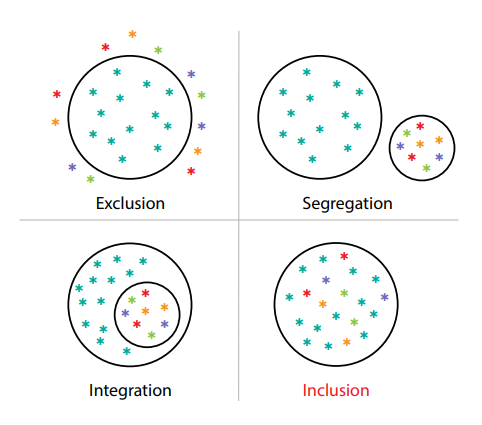Before I started the teaching portion of EDUC 491, my coaching teacher and I sat down and looked at all of the IEPs that I would be working with in my practicum. This meant that I was taking these students and looking at ways I could shift my classroom to make it inclusive to everyone. An inclusive classroom is made up of diverse learners that are celebrated and not segregated. When I was wrapping my head around inclusive education and how I could do right by my students I came across the photo below and it helped put perspective in how I wanted my classroom to be.
I quickly established a rapport with each of my classes and recognized the unique nature of each group of students, as well as the individuals in each class. Each day I started with attendance and an individual “Hello” to each student and banter between students and myself. There were four students with IEPs distributed amongst the three classes, and I took the time to engage with each student and develop activities and assignments that would allow them to succeed. In the morning Social Studies 8 class, I recognized early on during my first formative assessment of writing that one student would be more successful with his written output if he could word process, as opposed to having to print or write, assignments. For most of the practicum period, I arranged for this student to have access to a laptop to complete and submit his written work. Adaptations were made for those who could not keep up with written output for notes, including distributing notes to these students, utilizing fill-in-the-blank notes, and utilizing table partners to assist where necessary.
This inclusive mentality was present throughout my practicum and at lunch I opened my classroom and encouraged students to come in and eat lunch – with the focus on it being a safe and quiet place for students to sit and talk quietly and avoid the clutter and congestion of the halls. I wanted my room to be a safe space and I started eating lunch in my classroom with the students so I could talk with them and get to know how I could be better for them.
Inclusive education is:
- Every student in the same room
- Every students is included in the classroom lesson and adaptations are made to include those students.
- Every student is an independent, valued member of the classroom community.
- Students have common classroom experiences where they interact with everyone else in the class.
These were my starting points for my final practicum and helped guide me to begin the building of an inclusive classroom, therefore practicing inclusive education within my foundation practicum.
